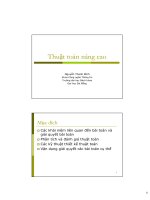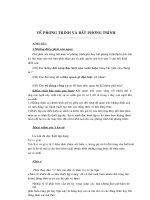Bài giảng về Preposition
Bạn đang xem bản rút gọn của tài liệu. Xem và tải ngay bản đầy đủ của tài liệu tại đây (1.14 MB, 17 trang )
KINDS OF PREPOSITIONS
Prepositions of place and position
Prepositions of movement
Other uses of prepositions
PROBLEMS OF USE
PREPOSITIONSI. Prepositions of place and
position:
* Prepositions show position
Ex:
Ted was sitting
next to
Janet.
The bank is
opposite
the cinema.
* Prepositions also show place
Ex:
I’m sitting
in
the room.
Sue lives
on
an island.
II. Prepositions of movement:
* Prepositions used with verbs of motion
(come, go, run, …) to show the direction of the
movement.
Ex:
Jan ran
out of
the room.
* Other examples: to, into, across, around, up,
down, …
III. Other Uses:
III. Other Uses:
1. Prepositions are also used in time
expressions:
Prepositions also used in time expressions: at, on, in,
before, after, during, till, for, …
Ex: During
my absence, they have done so many evils.
Notes:
FOR and DURING indicate duration of time.
2. Prepositions also cover a wide range
of meanings:
Ex:
This book is
about
Napoleon.
I cannot drink tea
without
sugar.
TO is often used with verbs of motion.
Ex:
- That airplane flies
to
Japan.
- We decide to go
to
the museum.
- They moved the table
to
the corner.
AT cannot be used with verbs of motion.
Ex:
- The train will stop
at
Manchester.
- They arrived
at
the cinema at last.
- He will meet his friends
at
the party.
II. NEAR and NEXT TO:
NEXT TO: means “beside”
Ex:
- John is the boy who stands
next to
the door.
- The bookshop is
next to
the supermarket.
N
E T
X O
T
NEAR : + means “not far away from”
+ can be a matter of opinion
+ relies on each person’s view
Ex:
- My birthday is very
near
Christmas.
- The supermarket is very
near
the station.
III. ABOVE and OVER:
Both mean “higher than”
Ex:
- There is something written
above / over
the door.
- They built a new room
above / over
the tree.
ABOVE is used in comparison with a stable object.
Ex:
There is a plane
above
the clouds.
The bridge is 160 feet
above
the sea level.
OVER is used to suggest closeness or touching.
Ex:
He put a blanket
over
the sleeping child.
They spread the map
over
the table.
IV. IN and AT: Places
IN refers to towns, countries and the “inside” of
places.
Ex:
- They live
in
England.
- Yesterday she was
in
the city.
- My sister is
in
the garden now.
AT refers to points with a particular purpose rather than
“inside”.
Ex:
- She lives
at
home.
- He met her
at
the park.
V. Prepositions at the end of a sentence:
Ex:
What are you seeking
for
?
It’s quite a hard problem to deal
with
!
That‘s the man whom I am waiting
for
.
- Can be found in
questions, infinitive clauses, relative clauses,
…
- Usually go with verb.
Question
Infinitive
Relative Clause
VI. Other uses:
1. Some prepositions can be used as adverbs without an
object.
Ex:
- There's a man with a dog sitting
opposite
.
- I can't see anyone
around.
2. There are many fixed phrases containing prepositions,
such as:
by mistake
,
on purpose
,
out of order
, …
Ex:
- Your guitar sounds awful! It seems to be
out of tune
.
- My Ferrari crashed into the lamp-post
by mistake
.









